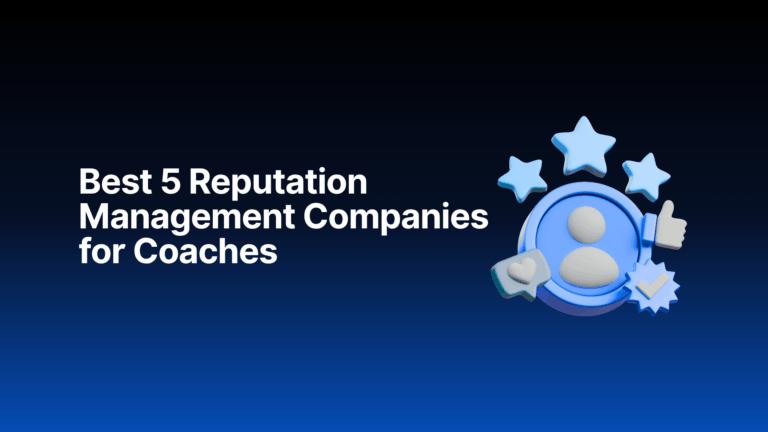Over 200 companies trust Media Removal. Get a Quote Now >
Reputation Management 101: How Brick-and-Mortar Stores Thrive in a Digital World

In today’s competitive retail landscape, the reputation of your brick-and-mortar business can make or break your success. With consumers increasingly relying on online reviews and word-of-mouth recommendations, managing your reputation both online and offline has never been more critical.
Reputation Management:
Brick-and-mortar businesses are more than just physical locations; they are hubs of community engagement, personalized service, and unique shopping experiences. Despite the growing prominence of e-commerce, the charm of visiting a store in person remains unmatched for many customers. However, the stakes are high. your store’s reputation is as vital as its products or services.
Reputation management goes beyond maintaining good customer relations. It requires consistent efforts to address customer feedback, create an engaging online presence, and ensure every touchpoint reflects your brand’s values.
This guide provides a comprehensive roadmap to mastering reputation management for brick-and-mortar businesses.
What is Reputation Management?
Reputation management involves monitoring and influencing how your business is perceived by others.
For brick-and-mortar businesses, this means ensuring that every customer interaction both in-store and online reflects positively on your brand.
It’s about creating a consistent, trustworthy image that encourages customer loyalty and attracts new patrons.
Unique Challenges for Brick-and-Mortar Businesses
- Immediate Customer Feedback: Unlike online stores, physical locations deal with customers face-to-face, leading to immediate reactions—both positive and negative.
- Online Amplification: A single in-store experience can quickly become public through online reviews and social media posts.
- Consistency Across Locations: For businesses with multiple stores, maintaining a consistent reputation can be challenging due to varying staff and local customer expectations.
Aligning your online reputation with the in-store customer experience is crucial. Discrepancies between what customers read online and what they experience in person can lead to dissatisfaction and loss of trust.
Why Reputation Management is Crucial for Brick-and-Mortar Businesses
Consider these statistics:
- 81% of shoppers research online before making a purchase in-store.
- 94% of consumers say a negative review has convinced them to avoid a business.
- Over 99% of customers read reviews when they shop online.
These numbers highlight the significant impact of online reviews on foot traffic and sales. In today’s digital age, your online reputation directly affects your offline success.
The Connection Between Reputation, Customer Trust, and Brand Loyalty
- Customer Trust: A strong reputation builds trust, encouraging customers to choose your store over competitors.
- Brand Loyalty: Satisfied customers are more likely to become repeat customers and recommend your business to others.
- Competitive Advantage: A positive reputation differentiates you in a crowded marketplace, attracting customers who might otherwise shop elsewhere.
Core Components of Reputation Management
To effectively manage your reputation, focus on these key areas:
Customer Service Excellence
Providing exceptional customer service is the foundation of a strong reputation.
- Staff Training: Ensure all employees are trained to provide friendly, knowledgeable, and efficient service.
- Empowering Staff: Allow employees to make decisions that enhance the customer experience, such as offering solutions to common problems without needing managerial approval.
- Feedback Loops: Create systems for customers to provide feedback directly, whether through comment cards, surveys, or in-person conversations.
Honesty and Transparency
Mistakes happen. How you handle them defines your business.
- Acknowledge Shortcomings: Be open about areas where you can improve. Customers appreciate honesty.
- Communicate Openly: If there’s an issue (like a product recall or service interruption), inform your customers promptly.
- Turn Negatives into Positives: Use criticism as an opportunity to demonstrate your commitment to customer satisfaction.
Local Listing Management
Ensure that your business information is accurate and consistent across all platforms.
- Claim Your Business Listings: Take control of your profiles on Google My Business, Yelp, TripAdvisor, and other relevant sites.
- Keep Information Updated: Regularly check that your address, hours, contact information, and other details are current.
- Enhance Listings with Photos and Descriptions: High-quality images and detailed descriptions can attract more customers.
Elevate Your Store’s Reputation Today!
Don’t let negative reviews deter potential customers. Partner with Media Removal to proactively manage and enhance your online presence.
Bridging the Gap Between Online and Offline Presence
Even as a brick-and-mortar business, your online presence significantly influences customer perceptions.
The Significance of a Strong Online Presence
- First Impressions: Many customers will encounter your business online before ever stepping foot in your store.
- Customer Engagement: Online platforms provide opportunities to engage with customers, answer questions, and showcase your brand personality.
Social Media Engagement
- Authentic Content: Share real stories, behind-the-scenes glimpses, and staff highlights to build a connection with your audience.
- Regular Updates: Keep your profiles active with consistent posts about new products, promotions, and events.
- Responsive Interaction: Reply to comments and messages promptly to show that you value customer engagement.
SEO-Optimized Location Pages
- Create Dedicated Pages: For each store location, have a unique page on your website with specific information.
- Include Essential Details: Address, operating hours, contact information, and any location-specific offerings.
- Local SEO Strategies: Use keywords relevant to your area to improve search engine visibility and attract local customers.
Proactive Reputation Management Strategies
Don’t wait for issues to arise, take steps to build a strong reputation proactively.
Encouraging Customers to Leave Reviews
- Ask Directly: After a positive interaction, invite customers to share their experience online.
- Simplify the Process: Provide links or QR codes that lead directly to your review profiles.
- In-Store Signage: Use signs or flyers to remind customers that their feedback is valued.
Leveraging Email and SMS Campaigns
- Follow-Up Messages: Send a thank-you email or text after a purchase, including a polite request for a review.
- Feedback Surveys: Use short surveys to gather customer insights and encourage reviews.
Showcasing Customer Testimonials
- Website Features: Highlight positive reviews and testimonials on your homepage.
- Marketing Materials: Include customer quotes in brochures, flyers, and advertisements.
- In-Store Displays: Use digital screens or bulletin boards to share customer experiences.
Tools and Technologies for Reputation Management
Managing your reputation can be complex, but the right tools simplify the process.
Overview of ORM Tools
- ReviewTrackers: Monitors reviews from multiple platforms, providing analytics and alerts.
- Customer Alliance: Offers a centralized inbox for reviews and AI-assisted response suggestions.
Features to Look For
- Review Monitoring: Real-time notifications of new reviews across platforms.
- Analytics: Insights into customer sentiment and trends.
- Competitor Insights: Compare your reputation with that of competitors.
- Centralized Response Platform: Respond to reviews from multiple sites in one place.
Benefits of AI-Powered Assistants
- Efficiency: Save time by generating draft responses to reviews.
- Insight Generation: Analyze large volumes of feedback for common themes.
- Personalization: Tailor responses while maintaining consistency.
Challenges in Reputation Management and How to Overcome Them
Common Pitfalls
- Ignoring Feedback: Failing to address customer reviews can harm your image.
- Inconsistent Messaging: Mixed messages can confuse customers and erode trust.
- Over Reliance on Automation: While tools are helpful, personal touch is essential.
Practical Tips
- Regular Monitoring: Set aside time daily or weekly to check reviews and mentions.
- Develop a Response Plan: Create guidelines for handling different types of feedback.
- Educate Your Team: Ensure all staff understand the importance of reputation management and how they can contribute.
Measuring the Success of Your Reputation Management Strategy
Tracking your progress helps you adjust your approach and celebrate successes.
Key Performance Indicators (KPIs)
- Average Rating: Monitor changes in your overall ratings on review platforms.
- Review Volume: An increase can indicate higher customer engagement.
- Response Rate: Aim for a high percentage of reviews responded to.
- Customer Sentiment: Use sentiment analysis tools to gauge overall perceptions.
Tools for Measurement
- Google Analytics: Track website traffic originating from review sites.
- Social Media Insights: Assess engagement levels and audience growth.
- ORM Software Reports: Utilize built-in reporting features for comprehensive data.
Conclusion
In an era where consumers are inundated with choices, your reputation sets you apart. For brick-and-mortar businesses, managing both online and offline perceptions is crucial. By focusing on exceptional customer service, embracing honesty and transparency, and actively engaging with customers both in-store and online, you can build a robust reputation that drives success.
Implementing the strategies outlined in this guide will not only help protect your brand but also foster stronger relationships with your customers. Remember, reputation management is an ongoing process that requires attention, dedication, and a genuine commitment to excellence.
Frequently Asked Questions
1. How often should I monitor online reviews?
It’s advisable to check for new reviews at least once a day. Regular monitoring allows you to respond promptly and address any issues before they escalate.
2. What should I do if I receive a fake review?
Report the review to the platform immediately, providing any evidence that supports your claim. While awaiting a response, consider posting a professional reply stating that you have no record of the incident but are willing to resolve any issues.
3. Can I remove negative reviews?
Generally, you can’t remove negative reviews unless they violate the platform’s guidelines. Focus on responding professionally and offering solutions to address the customer’s concerns.
4. Should I use templates for responding to reviews?
While templates can save time, it’s important to personalize each response to show genuine engagement and concern.
5. How can I encourage more customers to leave reviews?
Ask them! Provide reminders through receipts, email follow-ups, or in-store signage. Make the process easy by offering direct links or QR codes.
6. Is it acceptable to offer incentives for reviews?
Offering incentives can violate the terms of service for many review platforms and may lead to penalties. Instead, focus on providing excellent service that naturally encourages positive feedback.
7. What if a customer updates their negative review after we resolve their issue?
Thank them for giving you the opportunity to make things right and for updating their review. Reinforce your commitment to customer satisfaction.
8. How important is it to respond to positive reviews?
Very important. Responding to positive reviews strengthens customer relationships and encourages repeat business.
9. Can I ask customers to remove negative reviews after resolving their issues?
You can politely mention that you hope their concerns have been addressed, but avoid pressuring them to remove or change their review.
10. How do I handle a negative review that is factually incorrect?
Respond calmly, providing correct information without accusing the reviewer of dishonesty. Invite them to discuss the matter privately to resolve any misunderstandings.



